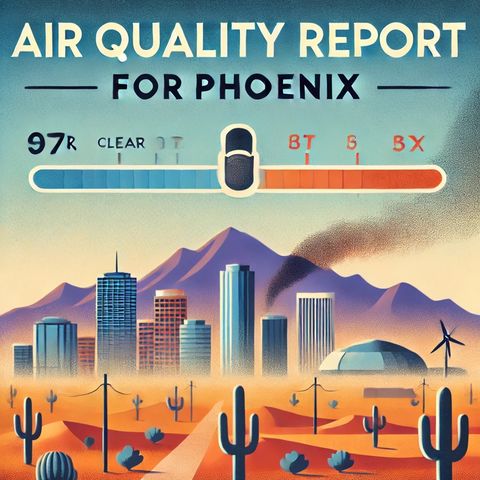Phoenix Air Quality Challenges Persist Due to Vehicles, Dust, and Industry

Download and listen anywhere
Download your favorite episodes and enjoy them, wherever you are! Sign up or log in now to access offline listening.
Phoenix Air Quality Challenges Persist Due to Vehicles, Dust, and Industry
This is an automatically generated transcript. Please note that complete accuracy is not guaranteed.
Description
I am unable to perform real-time internet searches or provide current data. However, I can offer general insights about factors that typically influence air quality in Phoenix, Arizona, and how...
show morePhoenix, situated in the desert region of the southwestern United States, often faces challenges with air quality due to a combination of natural and human-related factors. The city, part of the sprawling metropolitan area known as the Valley of the Sun, experiences weather conditions and geographical factors that can exacerbate air pollution.
One major contributor to air quality issues in Phoenix is vehicle emissions. As a city with an extensive network of roads and highways, the prevalence of cars and trucks contributes significantly to the levels of nitrogen oxides and volatile organic compounds. These pollutants, under the intense sunlight characteristic of the region, can lead to the formation of ground-level ozone, a harmful component of smog. Ozone levels tend to rise during the warmer months, posing health risks to sensitive groups, including children, the elderly, and those with respiratory conditions.
Another factor affecting Phoenix's air quality is dust. The city's arid environment means that dust storms, also known as haboobs, can occur, particularly during the monsoon season. These storms reduce visibility and increase the levels of particulate matter in the air. Particulate matter, especially fine particles known as PM2.5, can penetrate deep into the lungs and cause various health problems.
Industrial activities in and around Phoenix also contribute to air pollution, although regulatory measures have been implemented over the years to reduce emissions from these sources. Despite these efforts, occasional industrial emissions still impact air quality.
Monitoring air quality in Phoenix is essential for public health and safety. The Arizona Department of Environmental Quality (ADEQ) provides real-time air quality data and forecasts for the Phoenix area. They use the Air Quality Index (AQI) to inform residents about current conditions. The AQI categorizes air quality into six levels, ranging from good to hazardous, based on pollutant concentrations. Residents can access this information online or through local news outlets to make informed decisions about outdoor activities, especially on days with poor air quality.
To protect their health, people in Phoenix can take certain precautions during days with elevated pollution levels. Reducing outdoor activities, closing windows to limit indoor air pollution, and using air purifiers equipped with HEPA filters can help mitigate exposure. Additionally, using public transportation, carpooling, and advocating for clean energy sources can contribute to long-term improvements in air quality.
While today's specific air quality conditions cannot be provided, understanding the typical factors affecting Phoenix's air quality can help residents remain informed and proactive in managing their health and contributing to cleaner air.
Information
| Author | QP-5 |
| Organization | William Corbin |
| Website | - |
| Tags |
Copyright 2024 - Spreaker Inc. an iHeartMedia Company

Comments